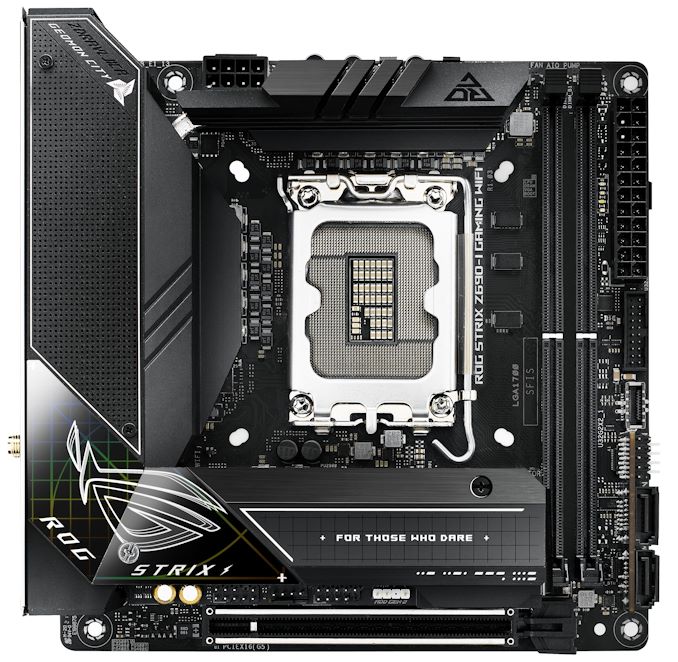The Intel Z690 Motherboard Overview (DDR5): Over 50+ New Models
by Gavin Bonshor on November 9, 2021 9:00 AM ESTASUS ROG Strix Z690-I Gaming WIFI (DDR5)
For Intel's 12th generation of Alder Lake desktop processors, ASUS has only made one mini-ITX board available for the launch of its LGA1700 offerings, the ASUS ROG Strix Z690-I Gaming WIFI. Designed for users looking to harness the big P and little E cores on Alder Lake, but in a small package, the Z690-I Gaming WIFI offers a solid feature set in a small form factor-friendly package. Being as small as it is, it still packs a punch in the design stakes, with a primarily black design, with contrasting elements including a tight mesh effect rear panel cover, glossy and matte black heatsinks, and an all-black PCB. In the bottom left-hand corner bridging the rear panel cover and M.2 heatsink is a ROG Strix branded cornerpiece.
Size playing an important role in PCIe support, the ASUS ROG Strix Z690-I Gaming WIFI has just one, a full-length PCIe 5.0 x16 slot. For storage is a pair of PCIe 4.0 x4 M.2 slots, with four SATA ports capable of supporting RAID 0, 1, 5, and 10 arrays. As space is restricted, ASUS includes two memory slots that are located on the right-hand side of the LGA1700 socket, with support for 64 GB, but we don't currently have what speed this model will support at this time.
Much like ASRock has done with its premium ITX models over the years, ASUS has adopted a similar style by including dual Thunderbolt 4 Type-C ports. Other USB options include two USB 3.2 G2 Type-A, three USB 3.2 G1 Type-A, and two USB 2.0 ports. There is a single HDMI video output, with three 3.5 mm audio jacks and S/PDIF optical output powered by a SupremeFX ALC4080 HD audio codec and Savitech SV3H712 amplifier pairing. Finishing off the rear panel is a solid networking array including one Intel I225-V 2.5 GbE port, as well as an Intel Wi-Fi 6E CNVi, and the panel also includes a BIOS Flashback button.












126 Comments
View All Comments
GeoffreyA - Saturday, November 13, 2021 - link
Certainly, there are tradeoffs, keeping a socket; but, as Mr. Tuvok would say, "Ryzen, you are an unending source of astonishment." There was a time when sockets even took CPUs from different manufacturers. I remember my Socket 7 motherboard, though I never tried it, could take a K5 and some Cyrix CPUs as well. Those 5x something, something. How things have changed.A short-lived socket can be a pain in the behind too. I was one of those unlucky folk who ended up with Socket 754 and missed out on dual-channel DDR and a long upgrade path. In any case, that computer went kaput after four years.
Oxford Guy - Wednesday, November 10, 2021 - link
Overclocking is for employees of motherboard companies.ECC RAM support should have been a standard feature from the beginning. Apple offered it on the Lisa in ‘83 and consumer computing has gone backward since.
Doublers, though... aren’t a bad thing as long as they’re implemented well — as I understand it. Better to have a good doubler implementation than a weak individual phase system. The main thing is to have a board meet the minimum spec for reliable (i.e. not overheating and/or failing) long-term support of its supported CPUs. Anything beyond that is unnecessary.
GeoffreyA - Saturday, November 13, 2021 - link
The problem with doublers is, they over-use it as a marketing technique to give the impression that a certain board has a large amount of phases.Oxford Guy - Saturday, November 13, 2021 - link
Weak phases with a mediocre/poor regulator aren’t necessarily better than ‘marketing phases’ via the use of doublers. That’s the case when the doublers are used a correctly.There are a lot of shenanigans, though — like not even utilizing the doubler fully but counting it as the doubling of phases. I also recall that one of the big tricks was putting extra chokes on the board to make it look like there are more phases.
GeoffreyA - Sunday, November 14, 2021 - link
Quite right, and one of the reasons why people have got to read a proper analysis of the VRM, or take a look at the lists on hardwareluxx for example.t.s - Tuesday, November 9, 2021 - link
Wish Intel go with their atv12vo. Or like business lines from HP, Dell, Lenovo, etc. 6 or 8 pin.shabby - Tuesday, November 9, 2021 - link
Mobo prices will go up even more, screw that.meacupla - Tuesday, November 9, 2021 - link
In the long term, I think the cost for ATX12VO will be cheaper.ATX12VO PSU will be cheaper than a comparable quality ATX PSU.
The BoM for 12V to 5V and 12V to 3.3V converters would go down, if mobo makers decide to stick to a single, standardized design.
With the way things are looking, electricity prices are unlikely to go down and continue to go up.
DigitalFreak - Tuesday, November 9, 2021 - link
All ATX12VO is doing is shifting the cost from the PSU to the motherboard.Wrs - Wednesday, November 10, 2021 - link
If mobo makers can stick to one design why can't PSU makers? They already conform to ATX.ATX 12 VO increases costs for piecemeal upgraders because of the simple observation that PSUs outlive motherboards. The question would be whether the power savings are worth it. For prebuilts they're comparing power savings to 0 net component cost so 12VO is already the norm.